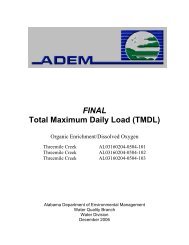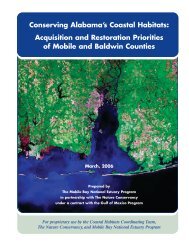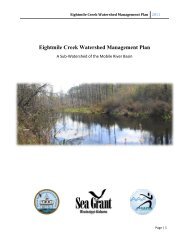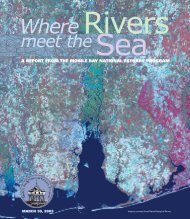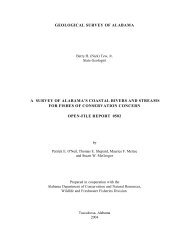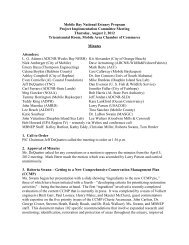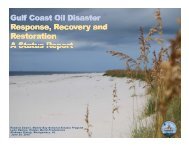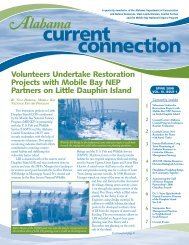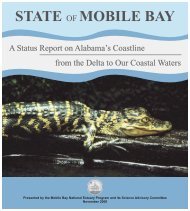Wolf Bay Plan Final - Mobile Bay National Estuary Program
Wolf Bay Plan Final - Mobile Bay National Estuary Program
Wolf Bay Plan Final - Mobile Bay National Estuary Program
- No tags were found...
You also want an ePaper? Increase the reach of your titles
YUMPU automatically turns print PDFs into web optimized ePapers that Google loves.
Pathogens include disease-causing bacteria and viruses associated with the presence of fecalmatter. Sources include failing septic systems, wastewater treatment plant (WWTP) overflows,boat sewage and animal waste.Sediment is eroded soil or sand that is transported to waterbodies via stormwater and can smotheraquatic habitat. Sources include poorly managed agricultural practices, dirt roads and constructionsites (Figure 15, Dirt roads).Litter or debris is another problem that threatens aquatic life and is unsightly. Sources are directlyconnected to human activity including illegal dumping, boat waste or litter.Thermal Stress is an elevation in water temperature that can harm native aquatic species andencourage nonnative species to spread. Sources include runoff from impervious surfaces suchas roads, parking lots, and roofs and the removal of streamside vegetation space that providedshading (NEMO, 2002).The majority of these water quality problems can be attributed to wastewater, human impacts,agriculture and construction. Agricultural and residential runoff contributes sediment, nutrients,pesticides and bacteria to surface water.A. CURRENT ENVIRONMENTAL MONITORING1. Residents believe there may be nutrient problems, however there is not sufficient data todetermine these effects. A nutrient monitoring pilot project has been developed for the watershedby the ACF and is expected to commence in the Spring of 2005.2. The ADEM Fish Tissue Monitoring <strong>Program</strong> was initiated in 1991 as a cooperative agreementwith ADPH, ADCNR and the Tennessee Valley Authority (TVA) to monitor fish tissue throughoutthe state for bioaccumulative contaminants that can cause a risk to human health, e.g. mercury.Each year’s sampling locations are determined based upon information available to the ADEMand input from the cooperative agencies.In 2003, ADEM conducted fish tissue sampling at one location (north of Mulberry Point) in the<strong>Wolf</strong> <strong>Bay</strong> watershed. Three samples from two species of fish (speckled trout and ladyfish) wereanalyzed. None of the results recorded by ADEM exceeded FDA or EPA action levels. There arecurrently no advisories in place for <strong>Wolf</strong> <strong>Bay</strong> (ADEM Lab Report). There are, however, severaladvisories in place for mercury contamination within coastal Alabama (Figure 14, ADEMMonitoring Sites).22



